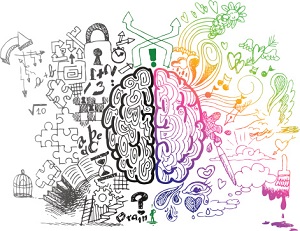Lateralization
 Lateralization characterizes the tendency of the hemispheres of the brain to perform different functions.
Lateralization characterizes the tendency of the hemispheres of the brain to perform different functions.
What is Brain Lateralization?
The brain is divided into a right and left hemisphere, though these hemispheres are not entirely separate. The two halves are connected by the corpus callosum, a bundle of nerve fibers. Each hemisphere tends to specialize in different tasks. Broadly speaking, the left side of the brain tends to control language, while the right tends to control visual imagery. Other specializations of each hemisphere include:
- The left hemisphere interprets the content of language while the right interprets the emotional meaning of words.
- The interpretation of faces and other visual input is accomplished by both hemispheres, but the right side of the brain is dominant in this task.
While certain areas of the brain tend to process certain pieces of information, both sides of the brain are involved in the majority of information processing, and damage to one side of the brain can affect the functioning of the other side of the brain. However, people who experience damage in an area of the brain dedicated to a specific function may begin processing information for that same function in another area of the brain.
Brain Lateralization and Handedness
The right side of the brain controls the left half of the body, and the left side of the brain controls the right half of the body. Some researchers have argued that, just as people have dominant hands, they may also have dominant brain hemispheres. Some research indicates that left-handed people, who only account for about 10% of the population, may process more speech in the right side of the brain than do right-handed people.
Criticism of Brain Lateralization Research
Some researchers argue that brain lateralization has been greatly overstated. For example, gender difference research has demonstrated that women women tend to use both sides of the brain more equally than do men. Some brain researchers have argued that this research is misleading, and some studies have shown that the brain is much less lateralized than previously thought.
References:
- Eliot, L. (2009). Pink Brain, Blue Brain: How Small Differences Grow into Troublesome Gaps—and What We Can Do about It. Boston, MA: Houghton Mifflin Harcourt.
- Griffin, R., Friedman, O., Ween, J., Winner, E., Happé, F., & Brownell, H. (2006). Theory of mind and the right cerebral hemisphere: Refining the scope of impairment. Laterality: Asymmetries of Body, Brain, and Cognition, 11(3), 195-225. doi: 10.1080/13576500500450552
- What is lateralization? (n.d.). All Psychology Careers. Retrieved from http://www.allpsychologycareers.com/topics/lateralization-right-brain-left-brain.html
Last Updated: 08-11-2015
Leave a Comment
By commenting you acknowledge acceptance of GoodTherapy.org's Terms and Conditions of Use.

